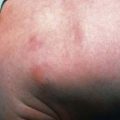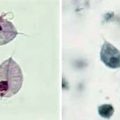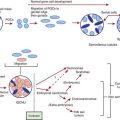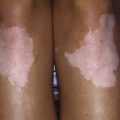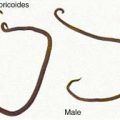Chapter 163 Miscellaneous Conditions Associated with Arthritis
Relapsing Polychondritis
Relapsing polychondritis (RP) is a rare condition characterized by episodic cartilage inflammation causing cartilage destruction and deformation in the external ears, nose, larynx, and tracheobronchial tree. Antibodies to native type II collagen are present in about a third of patients with RP, suggesting that an autoimmune reaction to this protein plays a role in its pathogenesis. RP may coexist with other autoimmune diseases, such as systemic lupus erythematosus. Patients may experience oligoarthritis or polyarthritis, uveitis, and hearing loss due to inflammation near the auditory and vestibular nerves. Children may initially relate only episodes of intense erythema over the outer ears. Cardiac involvement, including pericarditis and conduction defects, has been reported. Diagnostic criteria established for adults are useful guidelines for evaluating children with suggestive symptoms (see Table 163-1 on the Nelson Textbook of Pediatrics website![]() at www.expertconsult.com). The differential diagnosis includes Wegener granulomatosis (Chapter 161.4) and Cogan syndrome, which is characterized by auditory nerve inflammation and keratitis but not chondritis. The clinical course of RP is variable, and flares may remit spontaneously. Flares of disease are often associated with elevations of erythrocyte sedimentation rate (ESR). Many cases respond to nonsteroidal anti-inflammatory drugs, but some require corticosteroids or other immunosuppressive agents (azathioprine, methotrexate, hydroxychloroquine, colchicine, cyclophosphamide, cyclosporine, and anti–tumor necrosis factor [TNF] agents), as reported in small series and case reports. Severe, progressive, and potentially fatal disease resulting from destruction of the tracheobronchial tree and airway obstruction is unusual in childhood.
at www.expertconsult.com). The differential diagnosis includes Wegener granulomatosis (Chapter 161.4) and Cogan syndrome, which is characterized by auditory nerve inflammation and keratitis but not chondritis. The clinical course of RP is variable, and flares may remit spontaneously. Flares of disease are often associated with elevations of erythrocyte sedimentation rate (ESR). Many cases respond to nonsteroidal anti-inflammatory drugs, but some require corticosteroids or other immunosuppressive agents (azathioprine, methotrexate, hydroxychloroquine, colchicine, cyclophosphamide, cyclosporine, and anti–tumor necrosis factor [TNF] agents), as reported in small series and case reports. Severe, progressive, and potentially fatal disease resulting from destruction of the tracheobronchial tree and airway obstruction is unusual in childhood.
Table 163-1 EMPIRIC DIAGNOSTIC CRITERIA FOR RELAPSING POLYCHONDRITIS*
| MAJOR CRITERIA |
* The diagnosis is established by the presence of 2 major criteria or of 1 major and 2 minor criteria. Histologic examination of affected cartilage is not required.
From Michet CJ Jr, McKenna CH, Luthra HS, et al: Relapsing polychondritis: survival and predictive role of early disease manifestations, Ann Intern Med 104:74–78, 1986.
Sweet Syndrome
Sweet syndrome, or acute febrile neutrophilic dermatosis, occurs most often in young women. It is characterized by fever, elevated neutrophil count, and raised, tender erythematous plaques over the face, extremities, and trunk (Table 163-2). Some children also have arthritis. The syndrome may be idiopathic or secondary to malignancy (particularly acute myelogenous leukemia), drugs (granulocyte-colony stimulating factor), or rheumatic diseases (Behçet disease, antiphospholipid antibody syndrome, systemic lupus erythematosus). Skin biopsy reveals neutrophilic perivascular infiltrates in the upper dermis. The condition usually responds to treatment with corticosteroids.
| MAJOR CRITERIA |
* The diagnosis is established by the presence of 2 major criteria plus 2 of the 4 minor criteria.
From Cohen PR: Sweet’s syndrome—a comprehensive review of an acute febrile neutrophilic dermatosis, Orphanet J Rare Dis 2:34, 2007.
Belot A, Duquesne A, Job-Deslandre C, et al. Pediatric-onset relapsing polychondritis: case series and systematic review. J Pediatr. 2010;156:484-489.
Bussone G, Mouthon L. Autoimmune manifestations in primary immune deficiencies. Autoimmun Rev. 2008;8:332-336.
Cohen PR. Sweet’s syndrome—a comprehensive review of an acute febrile neutrophilic dermatosis. Orphanet J Rare Dis. 2007;2:34.
Sotiriou E, Patsatsi A, Tsorova C, et al. Febrile ulceronecrotic Mucha-Habermann disease: a case report and review of the literature. Acta Dermato-Venereol. 2008;88:350-355.


